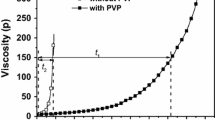Abstract
Various factors affecting the spinnability of the Si(OC2H5)4-H2O-C2H5OH-HCl solutions have been investigated in order to find appropriate experimental conditions for making gel-derived SiO2 glass fibres. The molar ratios of H2O, C2H5OH and HCl to Si(OC2H5)4 were changed in the range from 0.5 to 10.0, 0.5 to 7.0 and 0.001 to 0.1, respectively. The solutions were reacted at 30 and 80° C. It has been reconfirmed that the most important factor determining the spinnability of the solution in the course of the hydrolysis reaction is the molar ratio of water to Si(OC2H5)4 in the solution. The rise of the reaction temperature led to the remarkable shortening of the time required for drawing fibres. The increase of the amount of HCl decreased the upper limit of the H2O/Si(OC2H5)4 molar ratio range where the spinnability is found as well as reaction temperature. The solutions with a H2O/Si(OC2H5)4 ratio larger than 2.0 gave often fibres having a circular cross-section, while other solutions gave fibres with a non-circular one. The tensile strength of the gel-derived SiO2 glass fibres was also reported.
Similar content being viewed by others
References
S. Sakka, in “Treatise on Materials Science and Technology” Vol. 22, edited by M. Tomozawa and R. Doremus (Academic Press, New York, 1982) pp. 129–67.
S. Sakka andK. Kamiya,J. Non-Cryst. Solids 42 (1980) 403.
K. Kamiya, T. Yoko andS. Sakka,Yogyo-Kyokai-Shi 92 (1984) 242.
S. Sakka andK. Kamiya, “Materials Science Research” Vol. 17, edited by R.F. Davis, H. Palmour and R. L. Porter (Plenum, New York and London, 1984) pp. 83–94.
S. Sakka, K. Kamiya andT. Kato,Yogyo-Kyokai-Shi 90 (1982) 555.
F. O. Anderegg,Industr. Eng. Chem. 31 (1939) 290.
W. C. Lacourse, “Materials Research Society Symposium Proceedings” Vol. 32, edited by C. J. Brinker, D. E. Clark and D. R. Ulrich (Elsevier Science, North Holland, 1984) pp. 53–8.
R. Aelion, A. Loebel andF. Eirich,J. Amer. Chem. Soc. 72, (1950) 5705.
R. Iler, “The Chemistry of Silica” (John Wiley, New York, 1979) pp. 172–304.
Author information
Authors and Affiliations
Rights and permissions
About this article
Cite this article
Kamiya, K., Yoko, T. Synthesis of SiO2 glass fibres from Si(OC2H5)4-H2O-C2H5OH-HCl solutions through sol-gel method. J Mater Sci 21, 842–848 (1986). https://doi.org/10.1007/BF01117362
Received:
Accepted:
Issue Date:
DOI: https://doi.org/10.1007/BF01117362




